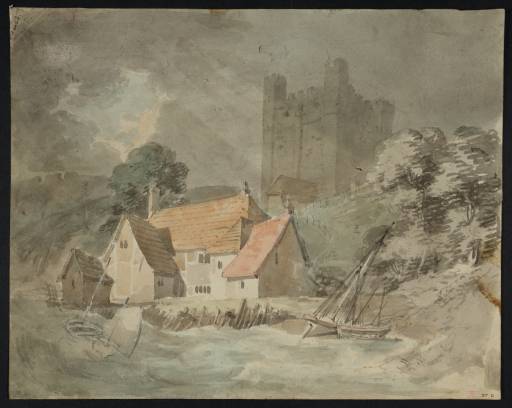Joseph Mallord William Turner Rochester Castle from the River c.1793
Joseph Mallord William Turner,
Rochester Castle from the River
c.1793
Joseph Mallord William Turner 1775–1851
Rochester Castle from the River c.1793
D00160
Turner Bequest XV D
Turner Bequest XV D
Pencil and watercolour on white wove paper, 215 x 270 mm
Inscribed in red ink ‘XV D’ bottom right (now faint)
Stamped in black ‘XV D’ bottom right
Inscribed in red ink ‘XV D’ bottom right (now faint)
Stamped in black ‘XV D’ bottom right
Accepted by the nation as part of the Turner Bequest 1856
References
1909
A.J. Finberg, A Complete Inventory of the Drawings of the Turner Bequest, London 1909, vol.I, p.19, XV D, as ‘Rochester Castle ... Stormy effect; river in foreground with boats, cottages on the banks, and castle beyond’. c.1793.
2001
David Blayney Brown and Kenneth Reedie, Turner and Kent, exhibition catalogue, Royal Museum & Art Gallery, Canterbury 2001, p.4.
Technique and condition
First Turner drew lightly in graphite pencil, followed by several applications of light wash. Further detailing was then added using a fine brush. Bower suggests that Indian ink was also used in the composition but this has not been analysed.
There are several fingerprints on both sides of the sheet in a brown oil-based paint. Around these prints oily staining is evident. There is also a splash of the same paint in the centre of the sheet, on the castle wall.
In the top left corner of the recto there is a faint red stain. Closer examination revealed this to be the remains of the letters ‘X’ and ‘D’, which were handwritten in red ink. These refer to the Finberg number and they were presumably written by Finberg himself in the 1930s. When the picture is the correct way up the letters are the wrong way around. The watercolour around them has also been scrubbed away. This suggests that these letters were written here by mistake (usually the Finberg number is in the bottom right-hand corner of the recto). When the mistake was realised it seems that attempts were made to remove the ink. Although this clearly reduced the red pigment it also removed some of the watercolour from the surrounding area. During conservation charcoal dust was used to infill the white patch in the sky caused by the removal of watercolour in this area. The dust was applied in tiny quantities using a cotton wool swab.
Helen Evans
January 2009
Revised by Joyce Townsend
February 2011
How to cite
Helen Evans, 'Technique and Condition', January 2009, revised by Joyce Townsend, February 2011, in Andrew Wilton, ‘Rochester Castle from the River c.1793 by Joseph Mallord William Turner’, catalogue entry, April 2012, in David Blayney Brown (ed.), J.M.W. Turner: Sketchbooks, Drawings and Watercolours, Tate Research Publication, December 2012, https://wwwThis drawing provides the best evidence for the existence of an early oil painting by Turner, ‘a view of Rochester Castle, with fishermen drawing their boats ashore in a gale of wind’. The work is not known, but Thornbury’s second-hand description of it (related by ‘one who has seen it’) is very detailed and specific:
it bears a strong resemblance to De Loutherbourg, and is well drawn; being carefully and thinly painted, with thin scumbles of semi-opaque colour used in so fluid a state as still to show where it had run down the picture from his brush. It reveals the experienced water-colour painter at first using a new and denser material timidly, and with a hesitating hand that was soon to grow more daring.1
The view, the atmospheric effect, and the foreground boats in this watercolour all suggest that a subject like the one Thornbury’s informant describes might have been developed from it. Compare the study of the Hot-Wells, Bristol (Tate D00389; Turner Bequest XXII O), from which Turner evolved a watercolour that he exhibited under the title The rising squall, Hot Wells, from St Vincent’s Rock, Bristol, in 1793, the year Thornbury gives for the execution of the Rochester oil.
Verso:
Blank; stamped in brown ink with Turner Bequest monogram.
Andrew Wilton
April 2012
How to cite
Andrew Wilton, ‘Rochester Castle from the River c.1793 by Joseph Mallord William Turner’, catalogue entry, April 2012, in David Blayney Brown (ed.), J.M.W. Turner: Sketchbooks, Drawings and Watercolours, Tate Research Publication, December 2012, https://www

